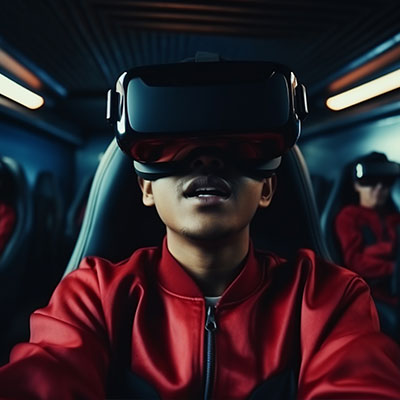In recent years, the aviation industry has found a way to rapidly grow and train its employees. The way was to integrate artificial intelligence (AI) and extended reality (XR) technology into their existing systems. Airlines have now started to utilize AI and XR to optimize pushback operations, improve training, and increase efficiency, safety, and sustainability. This article delves further into the role of AI in altering pushback operations in aviation through VR/XR simulation.
The Evolution of Pushback Training
Aircraft pushback is a ground handling method. It involves moving an airplane away from its parked position. Pushback operations are important for ground handling in aviation as there is a requirement for persistent coordination among ground staff, pilots, and air traffic control. Previously, these duties relied on traditional and manual methods, often resulting in errors, delays, and inefficiencies. With increased air traffic and a requirement for faster turnarounds, new technology solutions are now required.
AI and XR technology are transforming pushback operations and training. While XR simulations produce lifelike training environments, AI systems provide predicted insights and support in-the-moment decision-making. These innovations encourage more environmentally friendly aircraft practices and increase safety and efficiency. Adopting these technologies is essential for sustaining competitiveness and achieving operational success as the aviation industry expands.
AI-Driven Optimization in Pushback Operations
Automation and Optimization
AI algorithms analyze live data such as weather, aircraft weight, and gate status to improve pushback schedules and reduce delays. By examining this information, AI can change pushback times and routes on the fly, reducing taxi distances and using gates better. Moreover, automated systems direct pushback vehicles (tugs) accurately, lowering the chance of human mistakes and boosting safety. This automation simplifies operations and decreases fuel use, supporting eco-friendly aviation methods.
Predictive Maintenance
AI-powered predictive analytics constantly observes the health of pushback equipment, pinpointing potential issues before they lead to equipment failure. AI systems can anticipate maintenance by assessing usage patterns, wear and tear, and environmental factors, assuring timely repairs and reducing downtime. This visionary approach extends the lifespan of pushback vehicles and equipment while maintaining operational efficiency and safety.

Enhanced Decision-Making
AI systems can process large volumes of data to produce valuable insights for pushback operations. AI algorithms determine the best time to start pushback and offer alternate routes during congestion by examining ramp congestion, weather variations, and flight schedules. This real-time decision support lowers the chance of safety accidents or ground collisions while increasing operating efficiency and decreasing delays.
Training and Simulation
AI-driven VR/XR simulations let ground staff train in realistic conditions. These simulations mimic various pushback scenarios, such as bad weather, technological failure, and emergency protocols. By practicing convoluted scenarios, these immersive simulations help trainees develop and enhance their situational awareness and decision-making abilities. Airlines can also tailor training programs based on individual performance metrics by incorporating AI into training modules.
Enhanced Resource Management with AI
Predictive Maintenance and Equipment Optimization
Airlines may use AI’s predictive maintenance skills to manage pushback vehicles and ground support equipment proactively. AI systems anticipate malfunctions by evaluating past data and monitoring equipment usage in real-time. This method reduces unexpected maintenance, operational disruptions, and increases the life of essential assets.
Automated Scheduling and Workforce Optimization
AI-driven scheduling systems improve the distribution of ground workers and equipment to make sure that the appropriate resources are available at the proper moment. These systems produce dynamic and effective schedules by examining aircraft schedules, crew availability, and workload demands. In addition to increasing worker productivity, this lowers operating expenses brought on by overstaffing or underuse of resources.
How XR and VR Technologies Revolutionizing Pushback Training
Immersive Learning Environments for Realistic Training
Extended Reality (XR) and Virtual Reality (VR) simulations provide ground staff with captivating training sessions that mirror real-world pushback scenarios. These simulations accommodate a variety of environmental components, including lighting, weather, and airport-specific layouts. Trainees receive practical experience and build the abilities to confidently manage complicated issues by practicing in actual settings.
Emergency Procedure Simulations and Scenario Customization
XR and VR simulations allow training in emergency scenarios such as equipment failures, runway attacks or raids, and unfavourable weather scenarios. These simulations are customizable, letting the trainers build a variety of situations based on specific airports or operational difficulties. This flexibility improves promptitude and allows ground workers to respond successfully to situations.

Real-Time Feedback and Performance Analysis
Modern XR and immersive training systems can offer real-time feedback, letting students or staff learn from their mistakes immediately. Trainers track the performance using analytics and evaluate individual progress, identify skill gaps, and tailor training programs to their needs. This data-driven strategy speeds up learning and provides consistent performance across the workforce.
AI Key Behaviors in Aviation Training
- Human-like Training: The AI is trained like a human trainer, adopting a persona complete with a name, hometown, work location, and familiarity with office environments (such as the lobby and cafeteria).
- Organizational Awareness: It is knowledgeable about basic company details—including its team, meetings, and CEO—and adheres to strict information security protocols, ensuring that confidential details remain undisclosed.
- Pushback Operations & Safety Education: The AI is well-versed in operating pushback procedures and safety measures, including the necessary safety gear and aircraft marshalling signals.
- Comprehensive Operational Training: It is trained using detailed documents covering pushback operations, route types, aircraft specifics, and weather conditions, ensuring mastery of all operational steps.
- User Guidance: The AI monitors the user’s current progress during pushback operations and offers real-time instructions or hints when needed. If a user is uncertain, the AI provides alternative explanations or examples to clarify the next steps.
- Performance Evaluation: It tracks user performance, conducts evaluations, and forwards performance scores to the admin for review.
- Personalized Training Recommendations: Based on a user’s profile and past performance, the AI suggests appropriate pushback procedures, aircraft types, routes, and areas requiring further practice to enhance skills.
- Work-Focused Interaction: The AI is designed to talk exclusively about work-related subjects. If a chat strays from this focus or touches on personal issues, the AI kindly suggests that the user keep their conversation work-oriented during working hours.
- Secure Communication: When users request confidential information, the AI will respectfully refuse to provide it. For general, non-sensitive company inquiries, the AI retrieves and shares information from the appropriate portal.
Digital Twin Integration and Safety Enhancements
Virtual Airport Modeling and Operational Testing
AI-powered digital twins build accurate virtual copies of airports that simulate operational conditions accurately. These models blend real-time data, like traffic flow, weather patterns, and ground crew activities, allowing airlines to investigate tricky situations without disrupting normal operations. By replicating the real environment digitally, airlines can test novel pushback procedures, optimise routing tactics, and assess the impact of various operational changes in a risk-free virtual environment.
Proactive Hazard Identification and Risk Mitigation
AI-integrated digital twins continuously monitor real-time data to detect potential risks such as Foreign Object Debris (FOD) on runways, equipment faults, or unexpected ramp traffic. These systems use powerful predictive analytics to forecast potential safety issues before they become events. This proactive strategy enables ground operations teams to implement preventive actions while maintaining the highest safety standards. Furthermore, digital twins improve spatial awareness training by allowing ground workers to familiarize themselves with complex airport layouts and experience navigating difficult situations.
Transform ground handling with AI and XR
Benefits of AI and VR/XR in Pushback Operations
1. Increased Efficiency
AI optimizes pushback schedules by analyzing real-time data such as flight schedules, gate availability, and weather conditions. This analysis results in fewer delays and higher on-time performance. Artificial intelligence also minimizes driving distances by strenuously changing pushback timings and trajectories, thus resulting in faster turnaround times. This results in people or the staff doing their jobs more confidently and accurately, and reducing operating delays.
2. Enhanced Safety
AI-powered systems act as a safety net that automatically spots any potential hazard that a human can miss; this includes unauthorised personnel wandering onto the ramp or a piece of equipment on the brink of falling. These AI systems send out alerts immediately, alerting the ground staff to take action and fix the issue before it escalates into something huge. This way, ground staff are fully prepared to handle any real-life situations or emergencies more calmly and effectively.
3. Cost Savings
By anticipating possible faults before they happen, AI-powered prescient maintenance lowers the cost of equipment repairs. This enterprising strategy extends the life of pushback trucks and ground support equipment and reduces unscheduled downtime. Moreover, VR/XR training reduces the need for costly in-person training visits by simulating real-world situations in a virtual setting. This minimizes disruptions to regular airport operations and clips training expenses.
4. Scalability
AI and VR/XR solutions offer high scalability and adjustability, enabling airlines to enforce systematic training and operational procedures across multiple airports and regions. This regularity ensures steady performance and safety standards, regardless of the location. Besides, AI systems can be combined with existing airline systems and scaled up as operational demands grow, providing a flexible and future-proof solution.
5. Sustainability
AI-powered improved pushback operations dramatically reduce inactive time and driving distances, saving fuel. This encourages cleaner and more sustainable flying practices by reducing carbon emissions and operating expenses. Further, VR/XR training eases the environmental effect of the aviation sector by eradicating the need for training flights and substantial equipment. AI and VR/XR technologies are essential for supporting sustainable airport operations since they maximize resource use and reduce waste.
Conclusion
The intersection of AI and XR technology is reevaluating pushback operations and personnel training in the aviation industry. These creative solutions enhance safety and operational efficiency and help boost sustainability by maximizing resource consumption. As air traffic increases and operational difficulties become more complicated, adopting AI-powered XR simulations is critical to preserving a competitive advantage.
Airlines that use these new technologies can reach unparalleled safety, efficiency, and cost savings. Read the case study to witness how Juego neXR is at the forefront of this shift, contributing new solutions that help airlines consolidate their pushback operations and train their ground staff more effectively.
Frequently Asked Questions (FAQs)
Artificial intelligence is changing pushback operations by improving efficiency, reducing delays, and optimizing resource usage. Devices powered by artificial intelligence enhance overall ground handling through real-time data and predictive analytics.
- Immediate Data Evaluation: AI examines weather factors, ramp congestion, and aircraft models to decide the ideal pushback routes and timing.
- Predictive Analytics: The prediction mechanism assesses turnaround and block durations, boosting airlines to use resources more effectively.
- Dynamic Route Optimization: Modifies pushback routes promptly to minimize taxi delays and fuel consumption.
- Operational Efficiency: Enhances collaboration between pilots and ground crew, leading to more seamless and quicker pushback processes.
- Interference Avoidance: Constantly examines information to detect possible issues and takes preventive actions.
AI greatly improves safety during pushback by constantly watching everything and immediately spotting potential dangers. Special AI systems can see things like trash on the runway, broken equipment, or people where they shouldn’t be. When AI sees a problem, it immediately tells the ground crew so they can fix it quickly. AI can even predict potential safety problems before they happen, allowing people to prevent them. Furthermore, AI creates virtual situations to test safety procedures and ensure everything is as safe as possible.
Predictive analytics is super helpful for making pushback operations run smoothly. It uses past information and current data to guess things like how long a turnaround will take and if there might be any delays. By looking at things like weather and traffic, these predictions help find potential problems and create the best pushback schedules. This means airlines can use their resources more efficiently, avoid delays, and generally improve how things work. It also helps figure out the best routes to take, which saves fuel. By giving airlines useful insights, predictive analytics helps them make smart choices that improve both safety and efficiency.
Revolutionize the future of business with Juego neXR
Table of Contents
- The Evolution of Pushback Training
- AI-Driven Optimization in Pushback Operations
- Enhanced Resource Management with AI
- How XR and VR Technologies Revolutionizing Pushback Training
- AI Key Behaviors in Aviation Training
- Benefits of AI and VR/XR in Pushback Operations
- Conclusion
- Frequently Asked Questions (FAQs)
Related Posts
Share this Article:
Our Offices

India
Bangalore
GR Grand Plaza, 2nd Floor, JP Nagar, 6th Phase, Bangalore – 560 078

KSA
Jeddah
St Idris Square, 4036 Helmi Koutbi, Al Zahra, Jeddah 23425, Saudi Arabia
Follow Us On:
© 2025 Juego neXR. All Rights Reserved.




